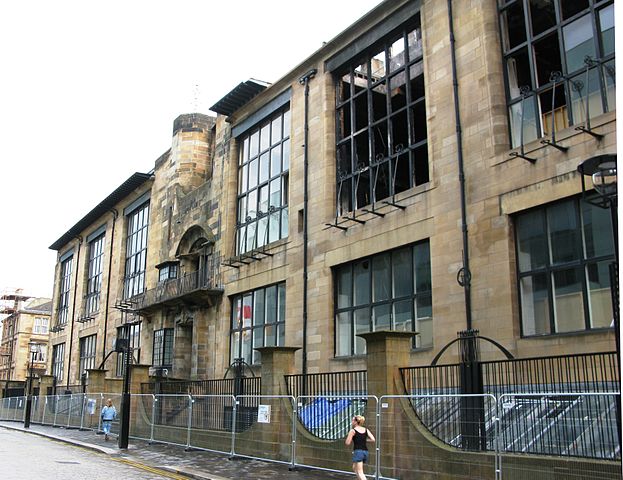Fire safety experts have criticised the decision to use flammable insulation in the £51m restoration of Glasgow School of Art’s Mackintosh Building, which was gutted by a blaze earlier this year
The 110-year-old building, including its internationally renowned library, was being restored after a devastating fire in April 2014. The project was being handled by architect Park/Page and contractor Kier.
The school’s director, Tom Inns, had previously said Kier’s assurances that an adequate fire safety strategy was in place had been “professionally checked”.
The investigation into the cause of June’s fire is ongoing but a number of experts have questioned the decision to use Polyisocyanurate (PIR) insulation, which comprises an insulation core sandwiched between aluminium foil facings, in a studio above the original library.
Geoff Wilkinson, managing director of Wilkinson Construction Consultants, told PBC Today that while PIR complies with the Building Regulations, it is “particularly concerning” that an alternative product wasn’t specified given the building’s historic nature and past fire safety issues.
“The likely driver would have been to improve the thermal performance of the building, which is a laudable aim, and, per millimetre of thickness, PIR is one of the best performing insulation products,” he said.
“However, it wouldn’t have been a dramatic reduction in performance to have used a non-combustible product or a product that at least had more limited flame propagation properties.
“Given all of that, you would have expected a fully responsible design team, considering the past history, to have specified a different product – even though PIR meets the minimum standard of the Building Regulations.”
Wilkinson added that under the Construction (Design & Management) Regulations 2015, there is a “wider remit” to minimise all known risks to acceptable levels.
“Regardless of whether the insulation complied with Building Regs or not, when you know there’s a particular risk or a past history with the building, all of that should be factored in as part of the CDM risk assessment – and that should be carried out for literally every material and piece of work that you do,” he said.
“So rather than the focus being on the Building Regs, it should have been down the fire risk assessment and the CDM assessment to ensure that you minimise the fire risk within that building.”
A spokesperson for the Glasgow School of Art said: “The GSA’s restoration plans went through Glasgow City Council’s thorough planning and historic building permission process, and were authorised through the issue of a Building Warrant.
“The Mackintosh Building was being restored using a combination of historic materials and craftsmanship.
“Any contemporary materials used in the restoration not only complied fully with the appropriate British and European Standard Institution specifications, but were also aligned with guidelines from specialist agencies such as Historic Environment Scotland and Historic England.”
PBC Today has approached Park/Page for comment.


















As per the attached Architects Journal Article, I completely agree with Geoff but haven’t pulled any punches with regard to the destruction of Glasgow School of Art.
As a independent fire & emergency planning expert commenting on both the 2014 & 2018 Glasgow School of Art fires & the Grenfell Tower Fire it’s staggering that PIR was used in this historic building.
It’s beyond belief that a temporary or phased fire suppression system installation was not operational at the time of the fire.
Hence the call for a Scottish Government Inquiry into both the 2014 & 2018 fires.
https://twitter.com/architectsjrnal/status/1031496805522059264?s=21
Have a huge amount of respect for Page & Park having worked with them on the Charles Rennie Mackintosh : 1999 City of Architecture & Design – Lighthouse
However compliance with life safety building standards do not go far enough when you have a unique world renound cultural legacy to protect. It needs a full fire risk based approach to life safety, property protection & business continuity – to protect the treasure for generations to come.
Until we learn of the contributing failures modes leading to he destruction of the building and contents; my opinion is that the GSOA management, design and construction team have failed spectacularly and we can never recover the original cultural character or atmosphere of Scotland’s & perhaps the world oldest working Art & Architecture School.
Drop me a message of additional commentary.
Steve Mackenzie
NB as a dyslexic please see past the errors & to realise the message within.